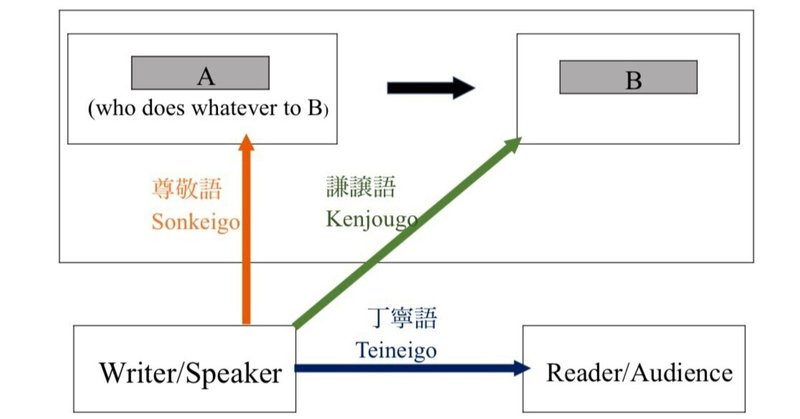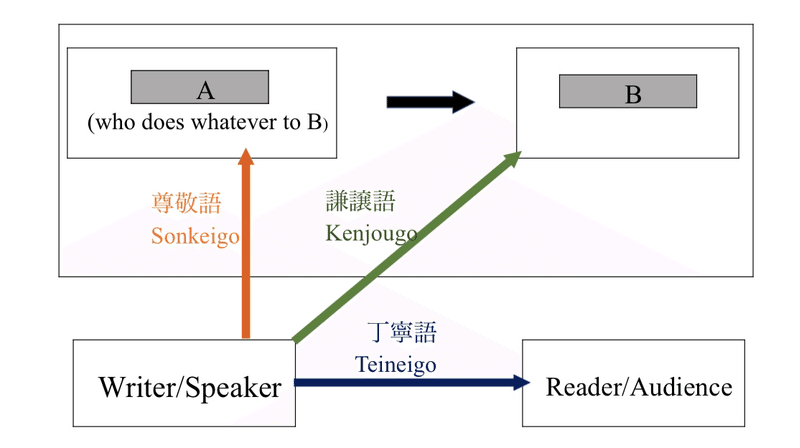
UNDERSTANDING KEIGO BASICS
What is Keigo? And how does it work?
We use honorifics speech/keigo in order to show respect. Being capable of use them properly is essential while talking to someone with a higher social standing than you.
Today, I'll show you the foundation of keigo as simple as possible, mainly focused on how three kinds of keigo differ each other.
The types of keigo and how to distinguish them.
Keigo can be devided into three main categories, teineigo, sonkeigo and kenjougo. Each of them has diffrent roles in term of who's shown respect.
Teineigo (Polite language)

Teineigo indirectly shows respect to who's listening to you by being polite.
Also it has the most common usage in the three types of keigo, while being the easiest one to learn. You can easily find natives using this honorifics in workplace or whenever they're talking to their elder.
Take a simple note that teineigo cosists of お~ and ご~ prefixes plus です, ます and ございます suffixes to get the vague idea of teineigo usage.
尊敬語にはない具体例入れる必要ある?
Sonkeigo (Respectful language)

Sonkeigo represents respect for the subject of the action.
For example, when you say 先生が間もなく教室に来る ("The teacher will come to the classroom soon"), you should use the honorifics to show respect to the teacher. In this case, you can use いらっしゃる (respectful form of "来る") to do the same thing. Furthermore, if you're talking to the senior classmate, you can add ます (a common suffix of polite language) and change いらっしゃる to いらっしゃります for the sake of showing regard for that classmate.
The confusing part of sonkeigo is that it can also used in nouns, adjectives and adjective verbs when these are tied to a specific person. Like, あの方は美しい("That person is beautiful") would turn into あのお方はお美しい, and 立派な趣味ですね (That's a nice hobby) would be ご立派なご趣味ですね ("立派" is an adjective verb). Again, these お~ and ご~ preffixes are sonkeigo because they're tied to a specific person. Althogh polite language/teineigo has same prefixes, they're unlerated to the person, お店 (A shop) and お酒 (An alcohol) are good instances.
So, you may wondering what if "A" in the above table is the person listening to you. Well, let me show you an example sentence, お酒はお飲みになりますか ("Would you drink any alcohol?"). Here, お酒 is teineigo and お飲みになる is sonkeigo.
As you can see, sonkeigo and teineigo won't overlap each other even if both of them express respect to the same person.
Note: You can't use sonkeigo/respectful language to yourself.
Kenjougo (Humble language)

The all boxes will not always filled. If the number of related perople or groups are less than four, please fill A and B box first.
Kenjougo is used for the object of an action. Unlike other two keigo, kenjougo pays respect by metaphorically lowering your own social status. In this sentence 明日ご自宅を伺います ("I will call at your house tommorow"), 伺い is kenjougo because it's your action. Some verbs have each humble forms like 伺う, but most of the time you can just put お or ご in front of the verb and する after to make it kenjougo, though thre're some alternatives of する. As you can see, kenjougo implys
Don't worry about same prefixes that came up again, you can easily distinguish them by paying attention to who's shown respect. Make sure to use the table above whenever you got confused how they vary each other.
aaaaaa
The explanation so far may be a bit vague, so I brought some example sentences to practice distinguishing keigos correctly.
こちらのお品物は袋にお入れいたしますか? ("Should I put this good in a bag?") お品物, お入れ, いたし and ます are keigo.
Here, there're two characters, a clerk and a customer. To fill the table, put the clerk in A and the writer box, and similarly, the customer for B and the listener box.
Since you can't use honorifcs to yourself, you can guess this sentence doesn't include sonkeigo.
Alternatingly, お品物 is untied to the customer so it's teineigo (after they purchased the good, it will turn into sonkeigo because they possess it and it's no longer unrelated to anyone). For お入れ, this is the clerk's action so kenjougo. Same for the いたし (humble form of "する"). Lastly, ます is teineigo suffix.今朝、総理が天皇陛下に新年のあいさつを申し上げなさりました (This morning, the Prime Minister extended New Year's greetings to His Majesty the Emperor.) 申し上げ, なさり, and まし are keigo.
Note: Contemporary, using kenjougo for other than in-group action (in-group refers to such things as your family and your company) is seen as wrong, please take this sentence as a very old usage that I brought up to explain how to use the table.
In the sentence above, the in-group notion expanded so much that it includes the Prime Minister showing respect for the Emperor, but again, this is an old kenjougo usage and some natives may feel odd because an apotheosis towards the Imperial Family has declined after WW2 even though the thought traces still remains nowadays.
Back to the example sentence, we can guess there're four characters, the Prime Minister, His Majesty the Emperor, the broadcaster, and the audience. In order to complete the table, fill box A with the Prime minister, and in the same way, box B with the Emperor and the speaker box with the broadcaster.
Starting off, 申し上げ is an action from the Prime Minister. and they are included in the in-group notion with the broadcaster as I noted before, so 申し上げ is kenjougo. Also, 申し上げ is a humble form of 言う.
Moving onto なさり, you may consider this as kenjougo too, but you can't use kenjougo to the two words next to each other (no need to remember this), so it's sonkeigo. Please just remember なさり is the sonkeigo form of する. Lastly, まし is simply a teineigo suffix.
My opinion on learning Keigo
Keigo is difficult because there're so many words/forms to learn although we barely use them in our daily lives. In the other words, mastering keigo would be a good sign that you became as fluent as natives, maybe even more.
While kanji or idioms-related problems are easily solved by googling, keigo is not. You need to understand what is keigo. If you don't want to be rude, start studying it.
However, if you're here just for chatting with Japanese friends or for watching anime, I would say using です and ます suffixes from teineigo solves like 90% of the problems. They work in a way not being too polite or too casual.
Hopefully, this guide helped you a little about keigo. By the way, I rewrote this article which I first made a year and a half back to see how I improved, but guess I still suck lol.
Anyways, I wish your effort will bring you a brilliant result, have a great experience!
この記事が気に入ったらサポートをしてみませんか?
